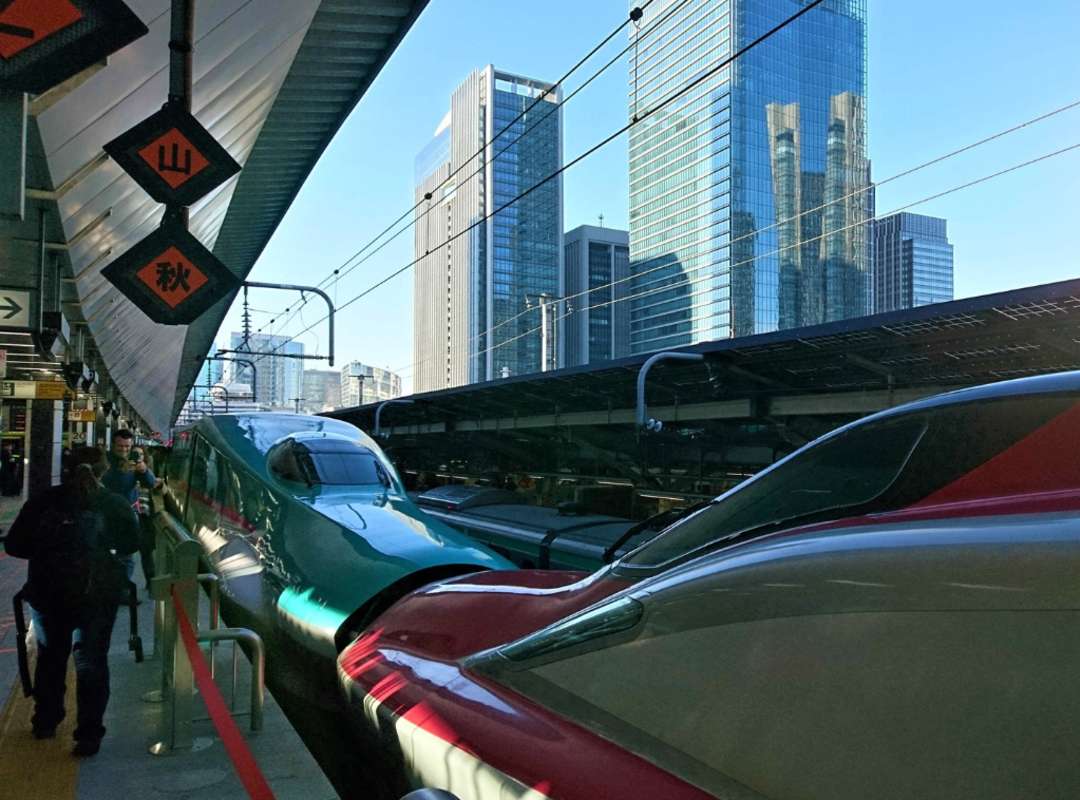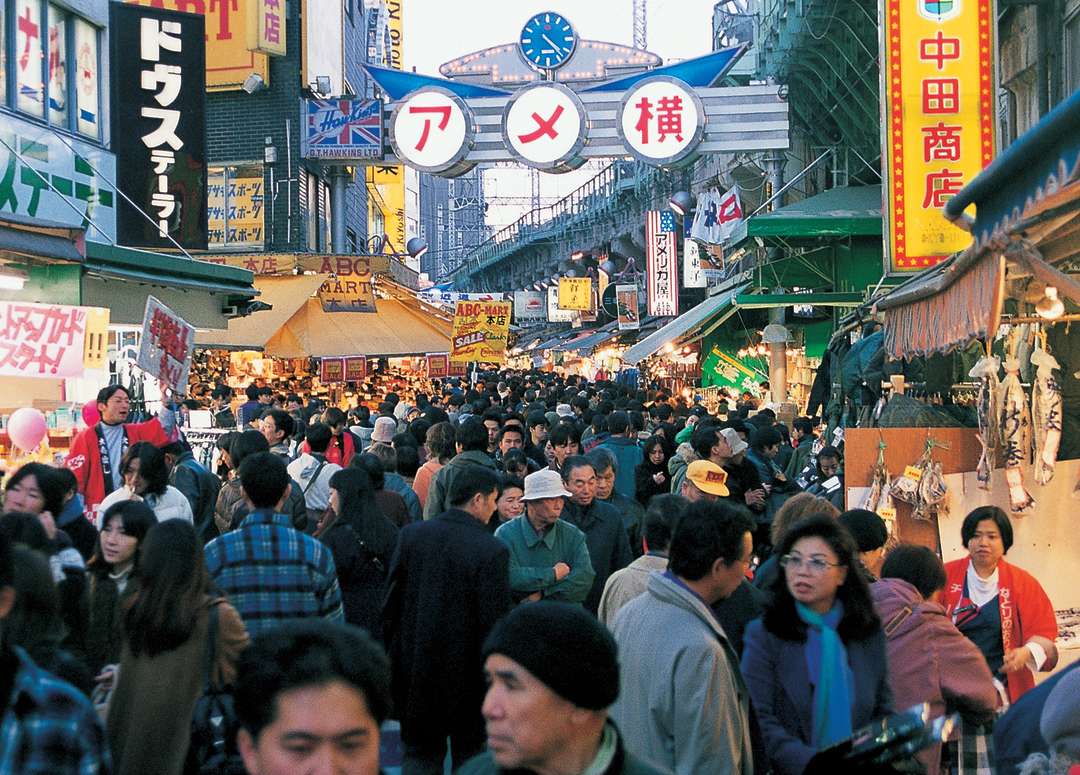 Shinkansen bullet trains 'kissing' at Tokyo station
Shinkansen bullet trains 'kissing' at Tokyo station
Bullet Train, the film adaptation of Kotaro Isaka's pulse-pounding novel of the same name, has now arrived and is ready for boarding! One of the film's biggest quirks is that most of the action takes place inside the walls of a bullet train, racing through all sorts of themed carriages. We do get a small glimpse, though, of some of the incredible places the train hurtles past at each of the stations it stops at, en route from Tokyo to Kyoto. So what did Brad Pitt miss out on in each of the destinations along this iconic trainline?
Tokyo
 The busy markets of Ameyokocho around Ueno station ©TCVB
The busy markets of Ameyokocho around Ueno station ©TCVB
The action of the movie all begins with a happy-go-lucky Brad Pitt making his way through the urban undergrowth of the Japanese capital, before stepping aboard one of the many bullet trains that leave the city in all directions every hour. An incomparable city like Tokyo will never be completed in just one trip, so get to know the districts and find the ones that suit your kind of travel. Roughly speaking, Tokyo is divided into its traditional North-East and its modern South-West, with the Imperial Palace at its heart. The North-East is where you'll find big historical names like Asakusa, the Kabuki-za Theater and the Sumo Stadium at Ryogoku, alongside the flea markets of Yanesen, and the tranquil area of Shibamata. The South-West is where you'll find the nightlife of Shibuya, the fashions of Harajuku and the glistening lights of Roppongi, but dig deeper and you'll also find the quirky cafes, youth culture and retro shops of neighbourhoods like Shimokitazawa and Koenji.
 The towering pillars of the Metropolitan Area Outer Underground Discharge Channel underneath Tokyo
The towering pillars of the Metropolitan Area Outer Underground Discharge Channel underneath Tokyo
An overnight trip out of the city centre also comes highly recommended, with such different experiences on offer that you'll forget you're only 30 minutes from the world's biggest city. Mt Takao offers amazing natural views over the city's skyline and is the gateway to the lush landscapes of the Okutama region, while a trip out by ferry south of Tokyo Bay will land you on the beautiful and remote Tokyo Islands. Better yet; jump on a train north of Tokyo into the suburbs of Saitama and discover the futuristic pop culture heaven of Tokorozawa, or the mysterious majesty of the rain water drainage chasms that lie right underneath the megalopolosis itself.
Shizuoka
 Mt Fuji framed in the distance by the harbour at Miho Bay and the Nihondaira tea fields ©TSJ
Mt Fuji framed in the distance by the harbour at Miho Bay and the Nihondaira tea fields ©TSJ
Shizuoka prefecture is so long that it actually enjoys the honour of being the 3rd prefecture with the most bullet train stops of any in Japan, after Yamagata in 1st place and Iwate in 2nd place. Not only that - it is also the loudest and proudest home prefecture of Mt Fuji, which we see right after Lemon and Ladybug's first altercation on the platform of Shizuoka Station. There are a number of different ways to 'do Fuji', whether you're stopping off at Atami to change trains for the 'fujimi' (lit. 'Fuji watching) terraces of the Izu Peninsula, or snaking your way into Fujinomiya at the foot of the great mountain to revel in street food and the Mt Fuji World Heritage Centre. However, nothing quite beats seeing Mt Fuji loom over the clinking masts of Miho Bay and the tumbling tea fields of Nihondaira Plateau, unique to the area just south of Shizuoka Station.
 A canopy of pine trees dappling shade over the sandy shores of Miho no Matsubara beach
A canopy of pine trees dappling shade over the sandy shores of Miho no Matsubara beach
Once you've ticked Fuji off the list, though, there's plenty still to take in. Hop the bullet train back a couple of stops to Kakegawa and you'll be able to experience some of the finest fresh green tea to ever come out of Japan, or wind your way back to the temple city of Shuzenji to explore the traditional ryokan inns, bamboo forests and wasabi fields of one of Shizuoka's most well-hidden gems. In fact, you'll only be doubling your set-jetting movie points as you taste the same spicy horseradish that coat a Japanese classic and Brad Pitt's favourite 'wasabi peas' in the film (just one of the interesting true facts behind the movie!)
Nagoya
 The giant silver globe of the Nagoya City Science Museum planetarium gleaming on a sunny day in Nagoya
The giant silver globe of the Nagoya City Science Museum planetarium gleaming on a sunny day in Nagoya
We don't get a good look at Nagoya Station in the film - a fun injoke for those who like to call it 'Japan's most boring city' - but we're here to correct that for once and for all! Nagoya is actually first mentioned in one of the Prince's many devious lies, as she claims to be an innocent passerby who missed her stop at Nagoya. However, there's more than reason enough to make sure you don't miss this stand-out of a Japanese city! As a hub of technology and innovation, this is a huge and vibrant city to explore, perfectly encapsulated in the sci-fi metal globe of the Nagoya City Science Museum. Space-age is the name of the game, with both the striking extra-terrestrial architecture of Oasis 21 shopping centre providing amazing rooftop views come sundown, and the symbolic Nagoya TV Tower (known as Thunder Tower for its fluorescent illuminations) boasting a sky-high art-deco hotel and an open air park 100 metres up on its Sky Deck.
 A heritage onsen hot spring ryokan overlooking the sea from the southern tip of Minamichita Onsen
A heritage onsen hot spring ryokan overlooking the sea from the southern tip of Minamichita Onsen
Nagoya comes alive at night, so remember to explore the Sakae and Shin-Sakae districts full of bars and clubs, and the delicacies on offer at the Kanayama Komachi street food stalls. Still, don't let that deter you from finding the quieter spots of calm. Nagoya is incredibly well connected to the green and historic outskirts of Aichi prefecture, with the pottery-paved streets of ceramic powerhouse Tokoname, the relaxing thermal baths of seaside Minamichita Onsen and the unique mix of cherry blossom and autumn leaves at Obara Shikizakura Park just a trainride away from the bullet train stop. And if all that weren't reason enough to stop by, the Nagoya area will also soon be welcoming the opening of the long-awaited Studio Ghibli Park!
Maibara
 The traditional architecture of 400yr old Hikone Castle
The traditional architecture of 400yr old Hikone Castle
Despite being located on the same auspicious line as Tokyo, Kyoto and Osaka, Maibara Station is definitely the underdog on this list. However, just like the mysterious character of the Elder who joins the drama here amidst a sea of lakeside fog, Maibara is not to be underestimated, particularly given the fact that Japan's largest lake, Lake Biwa, and one of Japan's best-preserved castles, Hikone Castle, lie right on its doorstep. Built around 1622, the castle at Hikone is a rare example of heritage enshrined, and perches snugly atop a fortress, immediately visible as soon as you step out of the station at Hikone, just 5 minutes from Maibara. After weaving your way around protective stone walls to the summit, you'll be treated to breathtaking views of the mirror-like surface of Lake Biwa and the retro shopping arcades of Hikone's old town.
 A rental 'mamachari' bike is parked up on the shores of Lake Biwa, Japan's largest lake ©Biwako Visitors Bureau
A rental 'mamachari' bike is parked up on the shores of Lake Biwa, Japan's largest lake ©Biwako Visitors Bureau
Once you've caught a glimpse of the shimmering waters, there's no way you'll not be wanting more and the best way to do that is by saddling up on two wheels and touring the floating torii gates, abandoned islands and untouched villages that sit on the various corners of Lake Biwa's expanse. Bike rental is available at various points around the circuit but Maibara Station is a fantastic launch pad for budding bikers and casual cyclists alike. Maibara Cycle Station has shower facilities and lets you drop off your rental bike at one of six designated rental stops around the loop, placing the scenic locales of Nagahama, Okishima and Shirahige well within your reach.
Kyoto
 The endlessly repeating row of Japanese 'torii' gates at Kyoto's famous Fushimi Inari Taisha
The endlessly repeating row of Japanese 'torii' gates at Kyoto's famous Fushimi Inari Taisha
As the bullet train hums towards its final destination, the action on the train kicks it up a notch with punches flying and samurai swords slicing through the air - a far cry from the gentler nature of Japan's former capital city and traditional heartland of Kyoto. Famous for its crazy concentration of over 2000 temples and shrines, Kyoto's streetscapes have maintained much of their 'machiya' townhouse charm after being spared the intense bombings that destroyed a lot of yesteryear's architecture in cities like Tokyo, Hiroshima and Nagasaki. This has made the city a real sight for sore eyes (and camera lenses) so make sure you pick your timing right! The city fills up in spring and autumn, but is remarkably quiet when winter comes to leave blankets of crisp white snow.
 The fisherman's huts of quaint and idyllic Ine in the northern area of Kyoto by the Sea
The fisherman's huts of quaint and idyllic Ine in the northern area of Kyoto by the Sea
It's also worth taking the time out to head off the beaten track. Within the bounds of Kyoto city lie many treasures, like the twin neighbourhoods of Kibune and Kerama joined by a temple-dotted hiking path in the city's mountainous north or Kanga-an Temple in the sleepy suburbs, which runs one of Japan's only temple bars looking out on a serene Japanese garden. Extra brownie points are given to the adventurous, and nothing comes as more of an adventure than forraying out of the city's walls and into Kyoto by the Sea. The magical fishing village of Ine, set amongst an archipelago of forested islets, is as memorable as it sounds with its picture-perfect dockside houses that sit directly on top of the water, bringing in the freshest of hauls that the Sea of Japan has to offer.
Interested in more BTS? Take a peek at our article here looking at the fact vs fiction when it comes to real life Japan.
Or to see the glistening lights of Tokyo on the small screen, check out our Japan fan guide to Ghostwire: Tokyo here.
For more information on Japan's incredible train networks and the '7 minute miracle', check out a day in the life of a Japan Railways cleaner here, or the full list of exciting bullet train openings coming over the next decade here.

















































